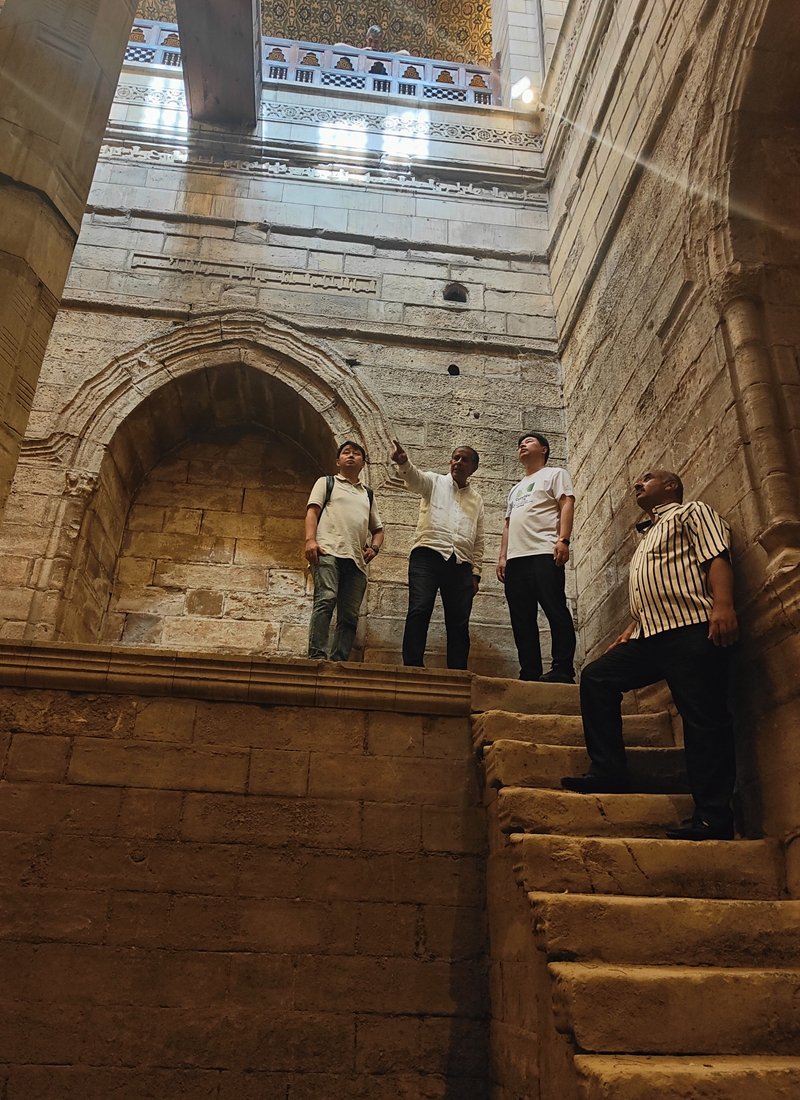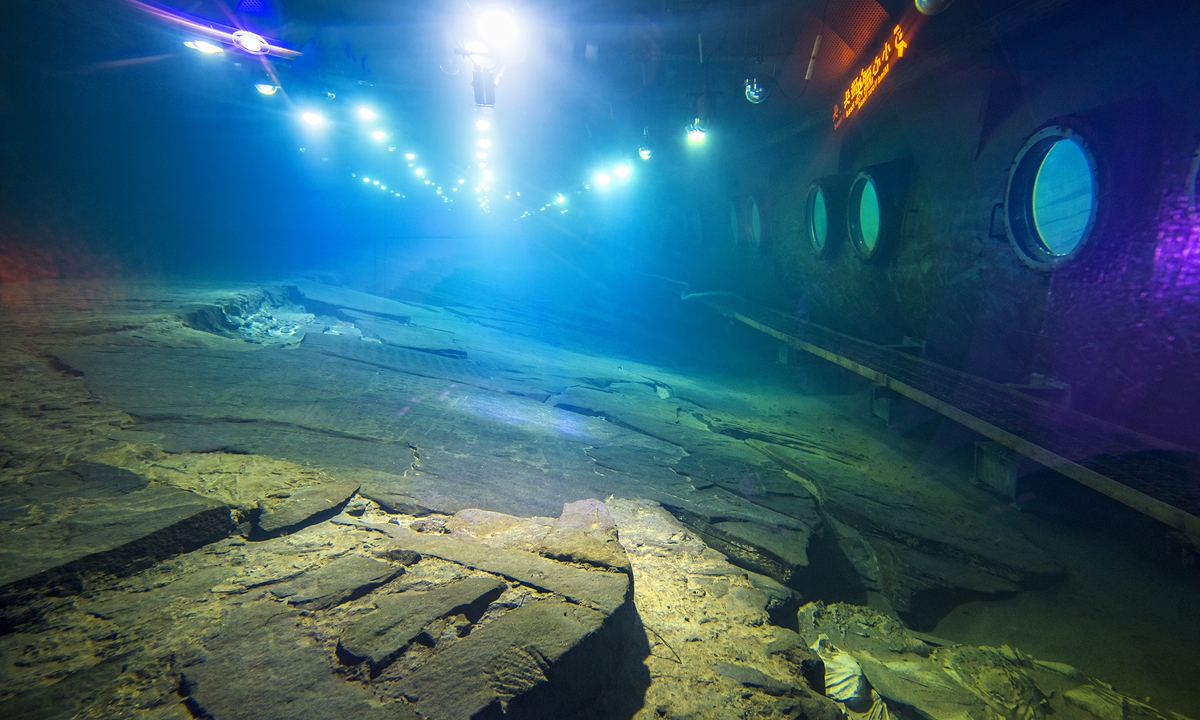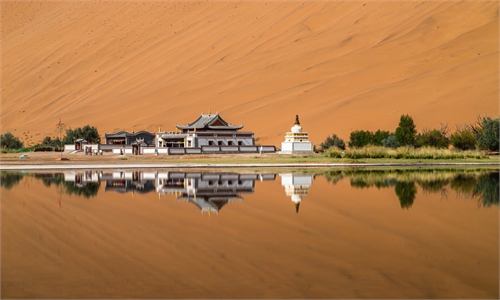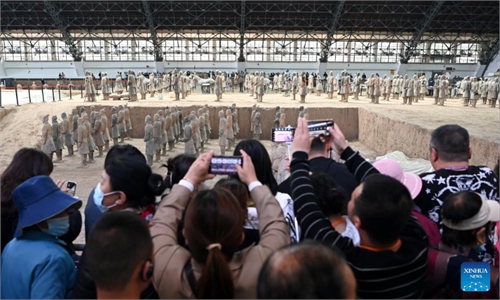ARTS / CULTURE & LEISURE
China-Egypt hydrological sites sprint for joint UNESCO title, paving roads in archaeology, heritage conservation

A group of Chinese cultural heritage experts, including Jiang Rui (left), director of the Baiheliang Underwater Museum, visit the site of the Rawda Island Nilometer in Egypt. Photo: Courtesy of Jiang Rui
Editor's Note:
Chinese President Xi Jinping for the first time proposed the principles of "zhen shi qin cheng" for China's Africa policy in a speech in 2013 at the Julius Nyerere International Convention Center in Tanzania.
Eleven years have passed since that momentous day in the history of China-Africa ties, but the principles endure. They have not only underpinned China's engagement with Africa in numerous fruitful cooperation projects, but also helped people get closer through exchanges and deepening friendships.
In areas of cultural heritage conservation and archaeology, China and Africa are working together to boost cooperation among Global South countries and contribute to the world with their example. In this issue of the special coverage of the 2024 Summit of the Forum on China-Africa Cooperation (FOCAC), Global Times reporters Li Yuche and Xu Liuliu share more details about the latest updates in this cooperation.

The underwater cultural heritage at the Baiheliang Underwater Museum Photo: Courtesy of Baiheliang Underwater Museum
A total of 1,223 natural and cultural sites across 168 countries are currently documented in the UNESCO World Heritage List. These sites are diverse, but one category that remains rare among them is hydrological heritage. Such a heritage epitomizes ancient human wisdom for managing waters to develop agricultural civilizations.
The picture of such a rare heritage is expected to be made clearer in the coming years, as the sites of the Rawda Island Nilometer in Egypt and the Baiheliang Ancient Hydrological Inscription in China are applying for a joint World Heritage title in 2026.
'Close inner bond'
Located in Cairo and Southwest China's Chongqing Municipality respectively, one similarity shared between the Rawda Island Nilometer and the Baiheliang Ancient Hydrological Inscription is 1,200-year-old well-preserved history.
The hydrological inscription Baiheliang, also known as the White Crane Ridge, was a 1,600-meter-long stone ridge in the Yangtze River. The stone ridge was dubbed an "underwater wonder" by UNESCO due to its coverage of 160 ancient inscriptions that document the river's water level records dating back to the Tang Dynasty (618-907).
The heritage represents how ancient Chinese people infused art into water engineering, since such inscriptions have been done in multiple Chinese calligraphic styles. Fish patterns are also engraved on stone tablets, to which the distance between the fishes' eyes and the water surface was an indicator of the river's lower flow.
When visiting the site in Chongqing, Ahmed Rehema, Associate Minister of Egypt's Ministry of Tourism and Antiquities, said that he was "deeply impressed by the inscriptions and stone fish carvings that were created by Chinese people in more than 1,000 years ago."
While noting the site marks one of the "world's oldest hydrological works of research," underwater archaeologist He Qiyi told the Global Times that human being's ingenuity in water management often dwells in the oldest civilizations in the world with developed agricultural traditions.
Around AD700, Egyptians had also harnessed managing river resources as represented by the Nilometer in Cairo. The Nilometer was used to measure flood levels, and the one on the Rawda Island is iconic because it was a marble octagonal column that was still functional in the 1950s to 1960s.
Ancient texts documenting vegetation growth and water parameters were engraved on the hydrological heritage. Recalling his visit to the site, Jiang Rui, director of the Baiheliang Underwater Museum, told the Global Times that he has seen a "close inner bond" between the two hydrological heritages.
Giving explanations on the two sites' modern value has been a focal issue ever since 2021 when a "feasibility study" of the two sites' application was carried out. In 2023, a Baiheliang-themed academic forum was launched to tackle the major issue of "discovering the two sites' similarities," he told the Global Times.
"We aim to finish the compilation of our joint application in 2025, and make an official application to the UNESCO in 2026," Jiang revealed to the Global Times.
Only a beginning
Years of preparation for the joint project have deepened exchanges between heritage experts in China and Egypt. In his experience of visiting the Baiheliang Underwater Museum, Rehema said that he was able to grasp China's "advanced technologies and mind-sets" for cultural relic conservation.
"Such experiences can inspire us to manage our underwater heritages in Egypt," Rehema emphasized.
In 2009, the Baiheliang Underwater Museum was built as the world's only dive-free museum under the water. It allows visitors to take 90-meter-long escalators in a glass tunnel that goes 40 meters under the Yangtze River.
"Our collaboration with Egypt enhances the developing countries' discourse power in interpreting their importance in protecting cultural heritages worldwide," Jiang said.
Sharing the exchange spirits encouraged by the China-proposed Belt and Road Initiative, apart from Egypt, China has become a partner to African countries in heritage conservation, arts exchange, and archaeology.
Focusing on Paleolithic archeological sites, China and Kenya recently signed a six-year plan starting from 2024 onward to support multiple excavations to be carried out in the two countries.
In 2022, China, for the first time, became the guest country of honor for the Biennale of Contemporary African Art in Dakar, Senegal.
That occasion marked how China and Senegal's long-standing civilizations are still a source of "cultural pride" for contemporary artists, while "making new dialogues regardless of territorial limitations," Yue Jieqiong, the Chinese pavilion's curator at the event told the Global Times.



